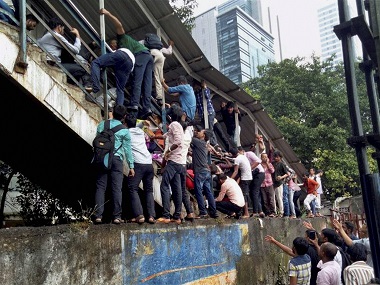At least
23 people were killed and over 30 injured after a stampede occurred on a foot-over bridge at Elphinstone Road station on Friday. While people were still speculating over the reason behind the tragedy, some pinned it on the
poor infrastructure of Mumbai local train stations and overcrowding. CNN-News18 released a CAG report of 2015, which nails the poor infrastructure of the Elphistone station in particular. The Elphinstone bridge is one the oldest in the city and has been a topic of debate for some time. [caption id=“attachment_4095133” align=“alignleft” width=“380”] People stuck in a stampede at Elphinstone station. PTI[/caption] This is the same stretch where renowned cardiologist Dr Deepak Amrapurkar had drowned in an open manhole late last month,
News18 noted. The irony of the debilitating structure and the man after after whom it was named is too conspicuous to miss.
The railway station, built in 1867, was named after one of the governors of Bombay, Lord John Elphinstone, who had ruled the then island city between 1853 and 1860. He was the last governor to serve under the East India Company.
In the book, Anchoring A City Line, authors and city historians Sharada Dwivedi and Rahul Mehrotra said the city’s progress in the 1850s and 60s was on account of the acumen of John Elphinstone. Speaking to The Indian Express, a city historian Deepak Rao said, “Lord Elphinstone was instrumental in the progress of this city. He had done much for the development of basic infrastructure and education during his tenure.” His uncle Lord Mountstuart Elphinstone was considered a pioneer in bringing infrastructural development to the city of Bombay. He was also single-handedly responsible for making Malabar Hills a residential area because he built the first-ever bungalow there to prove that the region is habitable. Lord John Elphinston was instrumental in demolishing the walls of the fort for the growth of the town and for the commencement of the Vihar water works that solved the city’s water woes. The irony lies in the fact that the Elphinstone station was about to be renamed Prabhadevi on Friday. This is seen as a move to go back to the genesis because a heritage enthusiast told The Indian Express that Prabhadevi is originally the name of this precinct because Prabhadevi shrine, dedicated to one of the seven deities that govern Bombay, is located in the area.


)




